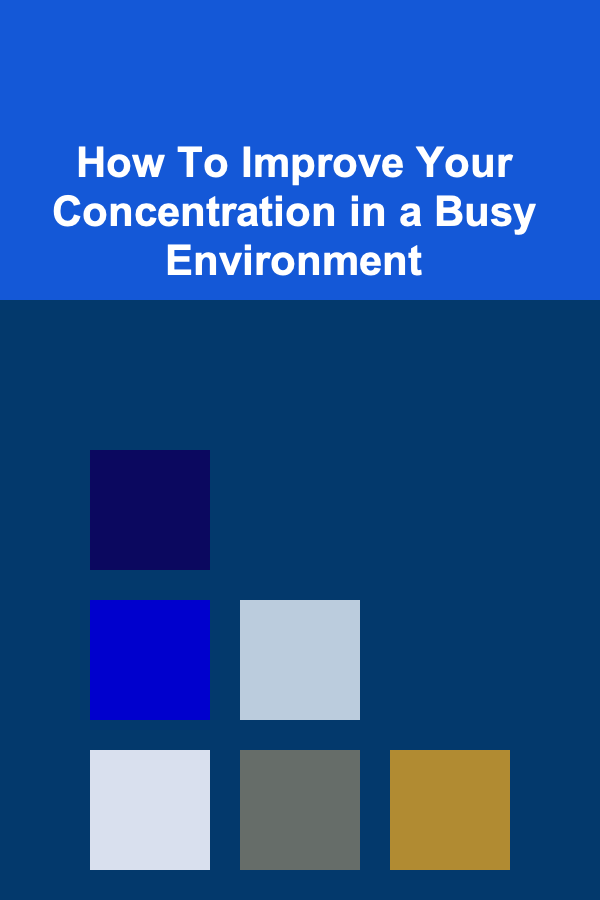
How To Improve Your Concentration in a Busy Environment
ebook include PDF & Audio bundle (Micro Guide)
$12.99$9.99
Limited Time Offer! Order within the next:

In today's fast-paced world, many of us are faced with distractions that threaten our ability to focus and concentrate. Whether you're working in a bustling office, studying in a crowded café, or simply trying to stay productive at home while your family goes about their daily routine, maintaining concentration in such environments can be challenging. However, improving concentration in these noisy, high-energy settings is not impossible. In fact, by understanding how concentration works and adopting certain techniques, anyone can significantly improve their ability to focus, even in the busiest environments.
In this article, we will explore the science behind concentration, the challenges posed by a busy environment, and practical strategies you can implement to enhance your focus. The goal is to help you optimize your ability to concentrate, regardless of the distractions around you.
Understanding Concentration
Concentration is the ability to focus your attention on a specific task while ignoring irrelevant distractions. It is a mental process that requires both cognitive control and sustained effort. While it may seem like a simple skill, concentration is actually quite complex and is influenced by various factors, including your emotional state, environment, physical health, and even your mindset.
The Cognitive Science of Focus
When you concentrate, your brain channels mental energy toward a particular task, shutting out distractions. This mental effort involves the prefrontal cortex, the area of the brain responsible for decision-making, attention, and controlling impulses. When we are faced with distractions, the brain constantly shifts between focusing on the task and being drawn toward the external stimuli. This constant toggling can drain cognitive resources and impair our ability to focus.
Neuroscientific studies suggest that the brain uses a process called selective attention to filter out irrelevant stimuli. This process is essential for concentration, but it requires energy and can be easily disrupted by environmental or internal factors.
The Role of Working Memory
Another critical aspect of concentration is working memory---the mental system responsible for holding and manipulating information over short periods. When working on a task, you rely on working memory to retain information, plan your next steps, and adjust your strategy as needed. A busy environment can overwhelm your working memory by introducing too many competing stimuli, making it harder to stay focused on the task at hand.
Challenges of Concentrating in a Busy Environment
In a busy environment, your ability to concentrate faces multiple challenges. These challenges come from both external and internal sources:
-
External Distractions
- Noise: Conversations, phone calls, traffic, and other environmental sounds are among the most common distractions.
- Visual Clutter: A cluttered workspace or the presence of people moving around can divert your attention.
- Interruptions: Colleagues, friends, or family members may interrupt you, breaking your concentration and requiring you to refocus.
-
Internal Distractions
- Mental Fatigue: Prolonged work or studying can deplete your mental energy, making it harder to focus.
- Stress: Anxiety about work, deadlines, or personal matters can take up mental space, reducing your ability to concentrate.
- Multitasking: Juggling multiple tasks at once can overload your cognitive resources and impair your focus.
These distractions contribute to a phenomenon known as attention residue, where switching between tasks or handling multiple stimuli can prevent you from fully concentrating on a single activity. This residue can linger even after the distraction is gone, making it harder to refocus.
Strategies for Improving Concentration in a Busy Environment
Now that we understand the science of concentration and the challenges posed by a busy environment, let's explore practical strategies to enhance focus.
1. Create a Dedicated Space for Work
One of the simplest yet most effective ways to improve concentration is to create a dedicated, distraction-free workspace. This could be a specific room or corner in your home or office that is reserved for work or study. A well-organized and quiet environment helps signal to your brain that it's time to focus.
Tips for Creating an Ideal Workspace:
- Minimize distractions: Remove unnecessary items from your workspace. Keep only the materials you need for the task at hand.
- Control noise: If noise is an issue, use noise-canceling headphones, play white noise, or listen to calming instrumental music to block out distractions.
- Ergonomics matter: Ensure your chair, desk, and computer setup are comfortable, as physical discomfort can also impair concentration.
2. Implement the Pomodoro Technique
The Pomodoro Technique is a time management method that breaks work into intervals, traditionally 25 minutes in length, separated by short breaks. This method helps you maintain focus by dividing your work into manageable chunks. It also prevents mental fatigue by giving you regular breaks to recharge.
How to Apply the Pomodoro Technique:
- Set a timer for 25 minutes and focus solely on one task during this period.
- After 25 minutes, take a 5-minute break. Use this time to relax, stretch, or walk around.
- After four Pomodoros, take a longer break of 15-30 minutes.
- The short breaks help you reset your focus and prevent burnout.
This technique is especially useful in a busy environment because it allows you to stay focused for short bursts, while also giving you the opportunity to refresh your mind.
3. Practice Mindfulness and Meditation
Mindfulness and meditation are powerful tools for improving concentration, especially in environments filled with distractions. Mindfulness involves staying present and aware of your thoughts, feelings, and surroundings without judgment. Practicing mindfulness allows you to train your brain to focus on the present moment and ignore irrelevant stimuli.
How to Practice Mindfulness:
- Mindful breathing: Spend a few minutes focusing solely on your breath. Inhale deeply through your nose, hold for a few seconds, and exhale slowly. This simple exercise helps center your attention.
- Body scan meditation: Take a few moments to mentally scan your body, paying attention to how each part feels, from your toes to your head. This can help you relax and sharpen your focus.
- Mindful walking: If you feel overwhelmed by distractions, take a short walk while paying close attention to each step you take, the sensation of your feet hitting the ground, and the sounds around you.
Mindfulness training can improve your ability to concentrate by enhancing your awareness of when your mind is wandering and helping you refocus on the task at hand.
4. Manage Your Energy and Avoid Mental Fatigue
Mental fatigue can significantly hinder your ability to concentrate. If you're feeling exhausted, your ability to focus will be impaired. To combat mental fatigue, it's essential to manage your energy levels throughout the day.
Energy Management Tips:
- Take regular breaks: Don't wait until you're feeling burned out to take a break. Step away from your work every hour or so to refresh your mind.
- Stay hydrated: Dehydration can cause fatigue and impair cognitive function. Drink plenty of water throughout the day.
- Get enough sleep: Lack of sleep affects concentration, mood, and overall cognitive performance. Aim for 7-9 hours of sleep each night to ensure you're well-rested and focused.
- Exercise regularly: Physical activity boosts circulation to the brain, improving cognitive function and reducing stress.
By managing your physical energy, you can maintain a higher level of concentration, even in a busy environment.
5. Limit Multitasking
While multitasking may seem like a time-saving strategy, it can actually reduce your ability to concentrate and increase the likelihood of errors. Research shows that multitasking divides your attention, leading to diminished performance and cognitive overload.
How to Avoid Multitasking:
- Focus on one task at a time: Prioritize your most important tasks and focus all your attention on completing them.
- Use task batching: Group similar tasks together and tackle them during specific times of the day. This prevents your brain from constantly switching between different types of tasks.
- Minimize interruptions: Turn off notifications on your phone and computer, and let people around you know that you need uninterrupted time to focus.
By limiting multitasking, you can improve the quality of your work and maintain a higher level of concentration.
6. Use Time-Blocking
Time-blocking is a productivity strategy where you allocate specific blocks of time to particular tasks or activities. This method helps you stay focused on one thing at a time and ensures that you're not jumping from one task to another without completing any of them.
How to Implement Time-Blocking:
- Schedule focused work periods: Block off time on your calendar for specific tasks. For example, allocate 9:00 AM to 11:00 AM for focused work on a project, followed by a 30-minute break.
- Plan for distractions: Acknowledge that distractions will happen. Schedule brief periods for checking emails or social media, but make sure that they don't interfere with your focused work time.
Time-blocking creates structure in your day, making it easier to concentrate on one task at a time without feeling overwhelmed by a busy environment.
7. Use Visualization Techniques
Visualization is a mental technique that involves imagining the successful completion of a task or project. By mentally rehearsing the process of completing a task, you can enhance your focus and reduce feelings of anxiety.
How to Use Visualization:
- Visualize your goal: Before starting a task, take a few moments to picture yourself successfully completing it. Imagine the steps you need to take and how focused you will be throughout the process.
- Visualize a distraction-free environment: If you're in a busy setting, visualize yourself working in an ideal, quiet space, which can help reduce the impact of the environment on your focus.
Visualization can help you stay motivated and improve your concentration by mentally preparing you for the task ahead.
Conclusion
Improving concentration in a busy environment is an ongoing process that requires understanding the nature of distractions and implementing effective strategies to stay focused. By creating a dedicated workspace, using time management techniques like the Pomodoro Technique, practicing mindfulness, and managing your physical and mental energy, you can significantly enhance your ability to concentrate, even in noisy or chaotic settings.
Remember, the key is to experiment with different techniques and find what works best for you. With consistency and practice, you can train your brain to stay focused and improve your performance, regardless of the distractions around you.

How to Clean Your Home After a Move or Before Moving In
Read More
How to Conduct a Targeted Job Search
Read More
How to Organize Your Laundry Room with Efficient Storage Solutions
Read More
How to Soundproof Your Floor from Noisy Neighbors Above
Read More
How to Practice Forgiveness for Mental Freedom
Read More
How to Write Clear and Concise Technical Specifications
Read MoreOther Products

How to Clean Your Home After a Move or Before Moving In
Read More
How to Conduct a Targeted Job Search
Read More
How to Organize Your Laundry Room with Efficient Storage Solutions
Read More
How to Soundproof Your Floor from Noisy Neighbors Above
Read More
How to Practice Forgiveness for Mental Freedom
Read More